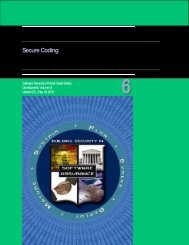Architecture and Design Considerations - Build Security In - US-CERT
Architecture and Design Considerations - Build Security In - US-CERT
Architecture and Design Considerations - Build Security In - US-CERT
You also want an ePaper? Increase the reach of your titles
YUMPU automatically turns print PDFs into web optimized ePapers that Google loves.
Table 2- Adapted from Saltzer & Shroeder “The Protection of <strong>In</strong>formation in Computer Systems”<br />
<strong>Design</strong> Principle<br />
What it Means<br />
Least common<br />
Minimize the amount of mechanism common to more than one user <strong>and</strong> depended on by all<br />
mechanism<br />
users. Every shared mechanism represents a potential information path between users <strong>and</strong><br />
Psychological<br />
acceptability<br />
must be designed with great care to be sure it does not unintentionally compromise security.<br />
It is essential that the human interface be designed for ease of use, so that users routinely <strong>and</strong><br />
automatically apply the protection mechanisms correctly.<br />
Resources<br />
» “Enhancing the Development Life Cycle to Produce Secure Software (EDLC).” Goertzel, Karen<br />
Mercedes, DHS SwA Forum Process <strong>and</strong> Practices Working Group, October 2008.<br />
.<br />
» “Software Assurance: A Curriculum Guide to the Common Body of Knowledge to Produce, Acquire<br />
<strong>and</strong> Sustain Secure Software.” Software Assurance Workforce Education <strong>and</strong> Training Working<br />
Group, DHS <strong>Build</strong> <strong>Security</strong> <strong>In</strong> (BSI) portal, October 2007. .<br />
» “The Protection of <strong>In</strong>formation in Computer Systems.” Saltzer <strong>and</strong> Schroeder,<br />
.<br />
» “The Ten Best Practices for Secure Software Development.” Paul, Mano, (ISC) 2 ,<br />
.<br />
» “Domain Separation by Construction.” William Harrison, Mark Tullsen, <strong>and</strong> James Hook,<br />
.<br />
Secure <strong>Design</strong> Patterns<br />
A software design pattern is a general repeatable solution to a recurring software engineering problem. Secure design patterns<br />
are descriptions or templates describing a general solution to a security problem that can be applied in many different situations.<br />
They provide general design guidance to eliminate the introduction of vulnerabilities into code or mitigate the consequences of<br />
vulnerabilities. Secure design patterns are not restricted to object-oriented design approaches but may also be applied to<br />
procedural languages. Secure design patterns provide a higher level of abstraction than secure coding guidelines. Secure<br />
design patterns differ from security patterns in that they do not describe specific security mechanisms such as access control,<br />
authentication, authorization <strong>and</strong> logging. Whereas security patterns are necessarily restricted to security-related functionality,<br />
secure design patterns can (<strong>and</strong> should) be used across all functional areas of a system.<br />
The Secure <strong>Design</strong> Patterns technical report, by the Software Engineering <strong>In</strong>stitute, categorizes three general classes of secure<br />
patterns according to their level of abstraction: architecture, design, <strong>and</strong> implementation. This section provides a brief summary<br />
of the architecture <strong>and</strong> design patterns. The technical report includes sample code that implements these patterns.<br />
13 Software Assurance Pocket Guide Series:<br />
Development, Volume V – Version 2.0, May 18, 2012
















